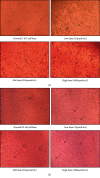Antioxidant and Antiproliferative Potential of Bioactive Molecules Ursolic Acid and Thujone Isolated from Memecylon edule and Elaeagnus indica and Their Inhibitory Effect on Topoisomerase II by Molecular Docking Approach
- PMID: 32149143
- PMCID: PMC7042705
- DOI: 10.1155/2020/8716927
Antioxidant and Antiproliferative Potential of Bioactive Molecules Ursolic Acid and Thujone Isolated from Memecylon edule and Elaeagnus indica and Their Inhibitory Effect on Topoisomerase II by Molecular Docking Approach
Abstract
The present study aimed to evaluate the antioxidant and antiproliferative potential of ursolic acid and thujone isolated from leaves of Elaeagnus indica and Memecylon edule and their inhibitory effect on topoisomerase II using molecular docking study. The isolated ursolic acid and thujone were examined for different types of free radicals scavenging activity, the antiproliferative potential on U-937 and HT-60 cell lines by adopting standard methods. Further, these compounds were docked with the active site of the ATPase region of topoisomerase II. The findings of the research revealed that ursolic acid harbor strong antioxidant and antiproliferative capacity with low IC50 values than the thujone in all tested methods. Moreover, ursolic acid shows significant inhibition effect on topoisomerase II with a considerable docking score (-8.0312) and GLIDE energy (-51.86 kca/mol). The present outcome concludes that ursolic acid possesses significant antioxidant and antiproliferative potential, which can be used in the development of novel antioxidant and antiproliferative agents in the future.
Copyright © 2020 Ramalingam Srinivasan et al.
Conflict of interest statement
The authors declare that they do not have any conflicts of interest.
Figures






Similar articles
-
Decoding the multifunctional potential of ursolic acid: antioxidant, antiproliferative, molecular dynamics, and biodegradability evaluations of a mangrove-derived terpenoid.J Comput Aided Mol Des. 2025 Apr 29;39(1):22. doi: 10.1007/s10822-025-00600-9. J Comput Aided Mol Des. 2025. PMID: 40299153
-
Synthesis of friedelan triterpenoid analogs with DNA topoisomerase IIα inhibitory activity and their molecular docking studies.Eur J Med Chem. 2012 Aug;54:137-43. doi: 10.1016/j.ejmech.2012.04.037. Epub 2012 May 8. Eur J Med Chem. 2012. PMID: 22633831
-
Identification of novel topoisomerase II alpha inhibitors by virtual screening, molecular docking, and bioassay.Chem Biol Drug Des. 2022 Jan;99(1):92-102. doi: 10.1111/cbdd.13927. Epub 2021 Aug 15. Chem Biol Drug Des. 2022. PMID: 34310071
-
Bioassays and In Silico Methods in the Identification of Human DNA Topoisomerase IIα Inhibitors.Curr Med Chem. 2018;25(28):3286-3318. doi: 10.2174/0929867325666180306165725. Curr Med Chem. 2018. PMID: 29508675 Review.
-
Marine-Derived Compounds Targeting Topoisomerase II in Cancer Cells: A Review.Mar Drugs. 2022 Oct 27;20(11):674. doi: 10.3390/md20110674. Mar Drugs. 2022. PMID: 36354997 Free PMC article. Review.
Cited by
-
GC-MS Chemical Profiling, Biological Investigation of Three Salvia Species Growing in Uzbekistan.Molecules. 2022 Aug 23;27(17):5365. doi: 10.3390/molecules27175365. Molecules. 2022. PMID: 36080131 Free PMC article.
-
Effect of sage (Salvia officinalis L.) extract in antioxidant status and intestinal morphology of pulmonary hypertensive chickens.Vet Med Sci. 2023 Sep;9(5):2176-2184. doi: 10.1002/vms3.804. Epub 2022 Apr 11. Vet Med Sci. 2023. PMID: 35405032 Free PMC article.
-
An Update on Pentacyclic Triterpenoids Ursolic and Oleanolic Acids and Related Derivatives as Anticancer Candidates.Antioxidants (Basel). 2024 Aug 6;13(8):952. doi: 10.3390/antiox13080952. Antioxidants (Basel). 2024. PMID: 39199198 Free PMC article. Review.
-
Ursolic acid attenuates oligospermia in busulfan-induced mice by promoting motor proteins.PeerJ. 2024 Jul 5;12:e17691. doi: 10.7717/peerj.17691. eCollection 2024. PeerJ. 2024. PMID: 38978752 Free PMC article.
-
Ursolic and Oleanolic Acids: Plant Metabolites with Neuroprotective Potential.Int J Mol Sci. 2021 Apr 27;22(9):4599. doi: 10.3390/ijms22094599. Int J Mol Sci. 2021. PMID: 33925641 Free PMC article. Review.
References
-
- Srinivasan R., Aruna A., Manigandan K., et al. Phytochemical, antioxidant, antimicrobial and antiproliferative potential of Elaeagnus indica. Biocatalysis and Agricultural Biotechnology. 2019;20 doi: 10.1016/j.bcab.2019.101265.101265 - DOI
-
- Srinivasan R., Natarajan D., Shivakumar M. S. Antioxidant compound Quercetin-3-O-α-L-rhamnoside(1→6)-β-D-glucose (Rutin) isolated from ethyl acetate leaf extracts of memecylon edule Roxb (Melastamataceae) Free Radicals and Antioxidants. 2015;5(1):35–42. doi: 10.5530/fra.2015.1.6. - DOI
-
- WHO. WHO Cancer Report 2018. Lyon, France: International Agency for Research on Cancer; 2018. https://www.who.int/news-room/fact-sheets/detail/cancer.
-
- Privitera G., Luca T., Castorina S., Passanisi R., Ruberto G., Napoli E. Anticancer activity of Salvia officinalis essential oil and its principal constituents against hormone-dependent tumour cells. Asian Pacific Journal of Tropical Biomedicine. 2019;9(1):24–28. doi: 10.4103/2221-1691.250266. - DOI
MeSH terms
Substances
LinkOut - more resources
Full Text Sources
Medical

